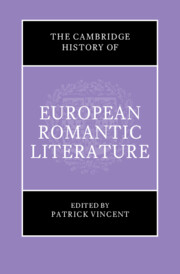Book contents
- The Cambridge History of European Romantic Literature
- The Cambridge History of European Romantic Literature
- Copyright page
- Contents
- Contributors
- Acknowledgements
- Note on the Text
- Chronology
- Introduction
- Part I Romantic Genealogies (1750–1790)
- Part II Revolution to Restoration (1790–1815)
- Part III Restoration to Revolution (1815–1850)
- 14 The ‘Restoration’ of the Restoration
- 15 Late Romanticism and Print Culture
- 16 Global Romanticisms
- 17 No Longer at Ease
- 18 Literatures of the North
- 19 Russian Empire and the Territories of Romanticism
- Further Reading
- Index
19 - Russian Empire and the Territories of Romanticism
from Part III - Restoration to Revolution (1815–1850)
Published online by Cambridge University Press: 10 January 2024
- The Cambridge History of European Romantic Literature
- The Cambridge History of European Romantic Literature
- Copyright page
- Contents
- Contributors
- Acknowledgements
- Note on the Text
- Chronology
- Introduction
- Part I Romantic Genealogies (1750–1790)
- Part II Revolution to Restoration (1790–1815)
- Part III Restoration to Revolution (1815–1850)
- 14 The ‘Restoration’ of the Restoration
- 15 Late Romanticism and Print Culture
- 16 Global Romanticisms
- 17 No Longer at Ease
- 18 Literatures of the North
- 19 Russian Empire and the Territories of Romanticism
- Further Reading
- Index
Summary
The final chapter addresses Russian Romanticism’s complex literary geographies and ambiguous links to Western Europe, Poland, and Ukraine. the chapter focusses on the period from the 1820s to the 1840s when modern Russian literature was catching up for the first time with the latest developments in Western culture. A period of Russian nationalism, messianism, and imperial expansion, it was also one in which writers were expanding their lyric, dramatic, and narrative repertoire. Contrasting the imaginary border regions of the North and the South, the chapter first discusses Bestuzhev-Marlinsky’s ethnographic account of the Caucasus penned in exile, then looks at how various writers, starting with two founding poets, Zhukovsky and Batiushkov, registered, but sometimes also contested Russian state ideology. It then compares Baratynsky’s, Gogol’s, and Viazemskii’s imaginary representations of the North, before dwelling on Shevchenko’s poems on Ukraine, Mickiewicz’s on Poland, and Pushkin’s on the Caucus, marked by the poet’s sense of entrapment. As the literary market shifted from poetry to prose, late Romantic writers including Lermontov and Gogol experimented with new hybrid forms and styles, both contributing to the rise of a politically-inflected realist fiction which, like elsewhere in Europe, began to supersede Romanticism by mid-century.
- Type
- Chapter
- Information
- The Cambridge History of European Romantic Literature , pp. 574 - 609Publisher: Cambridge University PressPrint publication year: 2023



